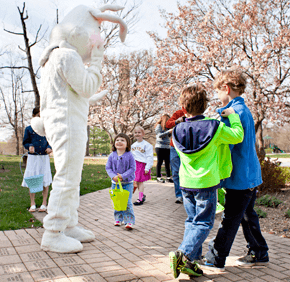Q: What does Easter celebrate?
A: Easter commemorates Jesus Christ’s resurrection from the dead, which was foreshadowed in the Old Testament and by Jesus himself, three days after his crucifixion. It also signifies new birth/life in Christ, which is why catechumens are baptized during Easter. By remembering Christ’s resurrection, we become aware that we too will rise again.
In his first Easter message last March, Pope Francis said that Easter “means that the love of God is stronger than evil and death itself; it means that the love of God can transform our lives and let those desert places in our hearts bloom. Jesus is risen, there is hope for you; you are no longer in the power of sin, evil. [It] “is the exodus, the passage of human beings from slavery to sin and evil to the freedom of love and goodness.”
Source: March 31, 2013 article regarding the pope’s first Easter, Catholic.com; Catechism of the Catholic Church Part 1: Section 2: Chapter 2: Article 5
Q: How long does the Easter season last?
A: The liturgical season of Easter lasts 50 days, starting with the first Sunday of Easter and ending with Pentecost.
Source: USCCB
Q: What is the Easter Triduum?
A: According to the National Catholic Register, “Triduum” is essentially Latin for “three days,” and thus refers to three days before Easter. The USCCB more specifically says that Easter Triduum “begins with the evening Mass of the Lord’s Supper on Holy Thursday, reaches its high point in the Easter Vigil, and closes with Evening Prayer on Easter Sunday.”
Source: Catholiceducation.com; USCCB; National Catholic Register
Q: Does the Church celebrate Easter on the same date every year?
A: No. According to religionfacts.com, the simplest way to explain it is that “Western churches (Catholic and Protestant) celebrate Easter on the first Sunday following the first full moon after the spring equinox.”
This means that Easter may take place anywhere between March 22 and April 25.
This year, the first full moon of spring is scheduled to be visible on Tuesday, April 15, so Easter occurs the following Sunday, April 20.
Source: religionfacts.com
Q: Why does the celebration of Easter coincide with a particular phase in the lunar cycle?
A: “Jesus rose from the dead the first Sunday following the Feast of Passover.” The calendar used to determine Passover in Judaism is “partly lunar.” Early Christians grew frustrated with the inconsistency of the Jewish calendar and their dependency on the rabbis who interpreted it, so they decided to create their own rule for determining the date of Easter.
Source: Catholic.com; Arlington Catholic Herald, reproduced by ETWN
Q: What is the history of Easter? How long has it been celebrated?
A: While the date of Easter and Christ’s Resurrection coincided with the pagan celebration of the pagan goddess of fertility and spring, it is not derived from pagan rituals. The church “redeemed” and “Christianized” the holiday for its own use. It is believed that Christians have been celebrating Holy Week since the second century.
Source: Catholic.com; April 2006 Zenit interview with Fr. Arcas; catholic.com quick questions
Q: What happens during the Easter Vigil?
A: As a nocturnal vigil, the Easter Vigil “begins and ends in darkness.” During what is known as the Service of Light, the Paschal Candle, which symbolizes “the light of Christ, rising in glory, scattering the darkness of our hearts and minds,” is lit from what is known as the “new” or “blazing” fire. The candle will remain burning until Pentecost Sunday. Following 7 Old Testament Readings and 2 New Testament readings (one from the Gospel, the other from Paul), catechumens to the Church receive the Sacraments of Baptism, Confirmation and the Eucharist, depending on their particular need, in the Rite of Christian Initiation.
Source: USCCB; Catholicculture.org
For more information: USCCB: Roman Missal and the Easter Vigil
USCCB: Questions and answers on the Tridiuum
Q: What liturgical colors are used for the Easter season?
A: White, which symbolizes new life, Christ as the light of the world and Christ’s triumph over death.
Source: Catholic.com
Q: What happens to the palms used during Palm Sunday Masses? Should they be disposed?
A: The palms used on Palm Sunday bring to mind Jesus’ entry into Jerusalem before his death on the cross. The crowds who accompanied him into the city waved palms at him.
The palms used during the Palm Sunday Mass are blessed, so when parishioners take them home, they should be kept until Ash Wednesday, when they can be burned for ashes.
Source: EWTN; National Catholic Register; catholicculture.org
Q: The Monday of Holy Week, there is a Chrism Mass. What is chrism oil?
A: Blessed with the oil of the sick and the oil of the catechumens at the Chrism Mass, chrism oil is a mixture of olive oil and balsam fragrance. It is used in the sacraments of baptism, confirmation and holy orders. It can also be used to anoint churches and altars as part of a church dedication ceremony.
Source: Arlington Catholic Herald, reproduced by Catholiceducation.org
Also see:
Chrism Mass is church ‘at its best’
Social media, smartphones give young people a new way to look at Lent


